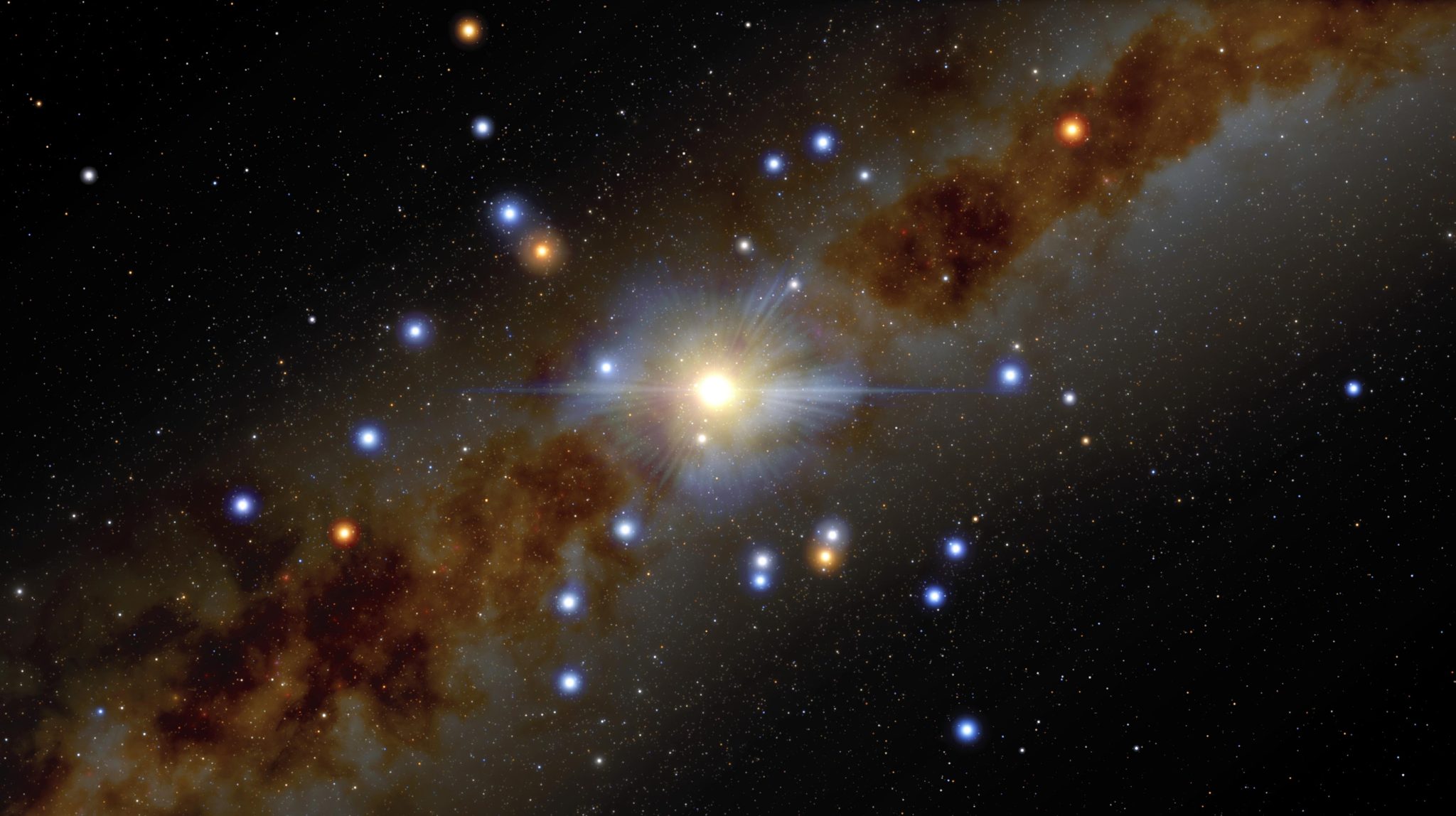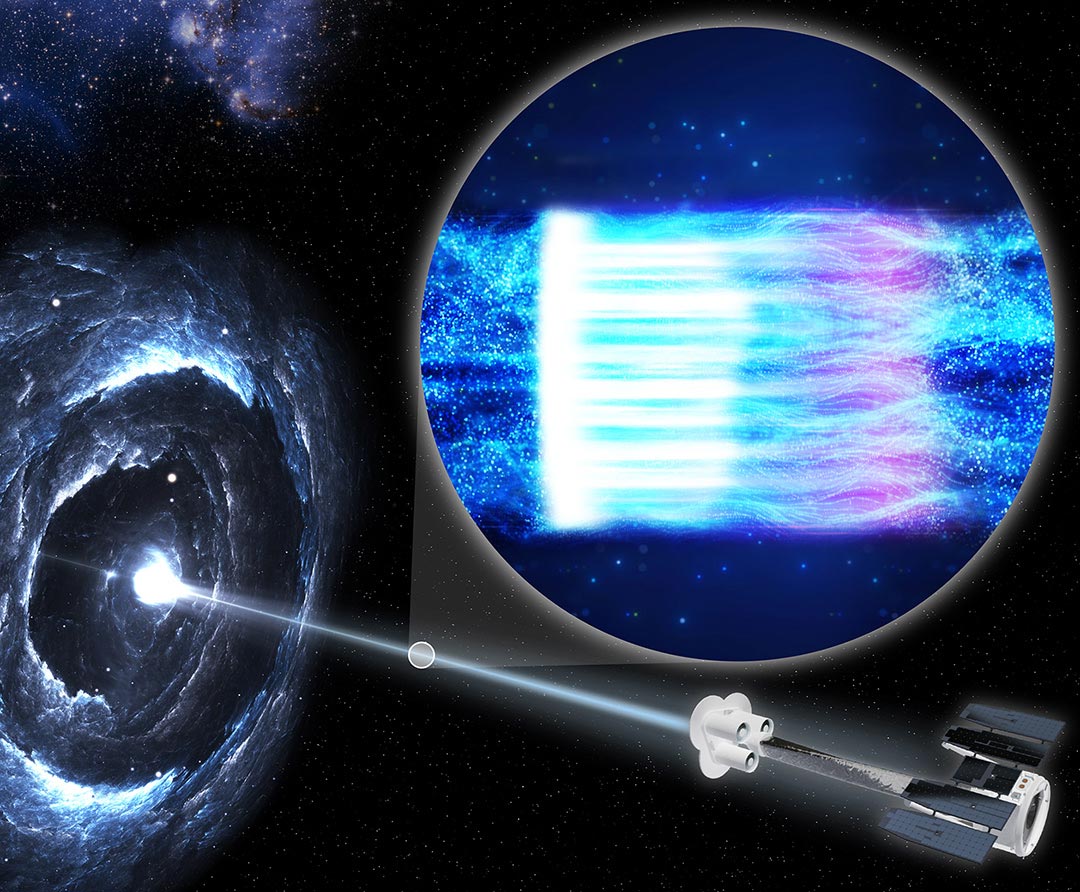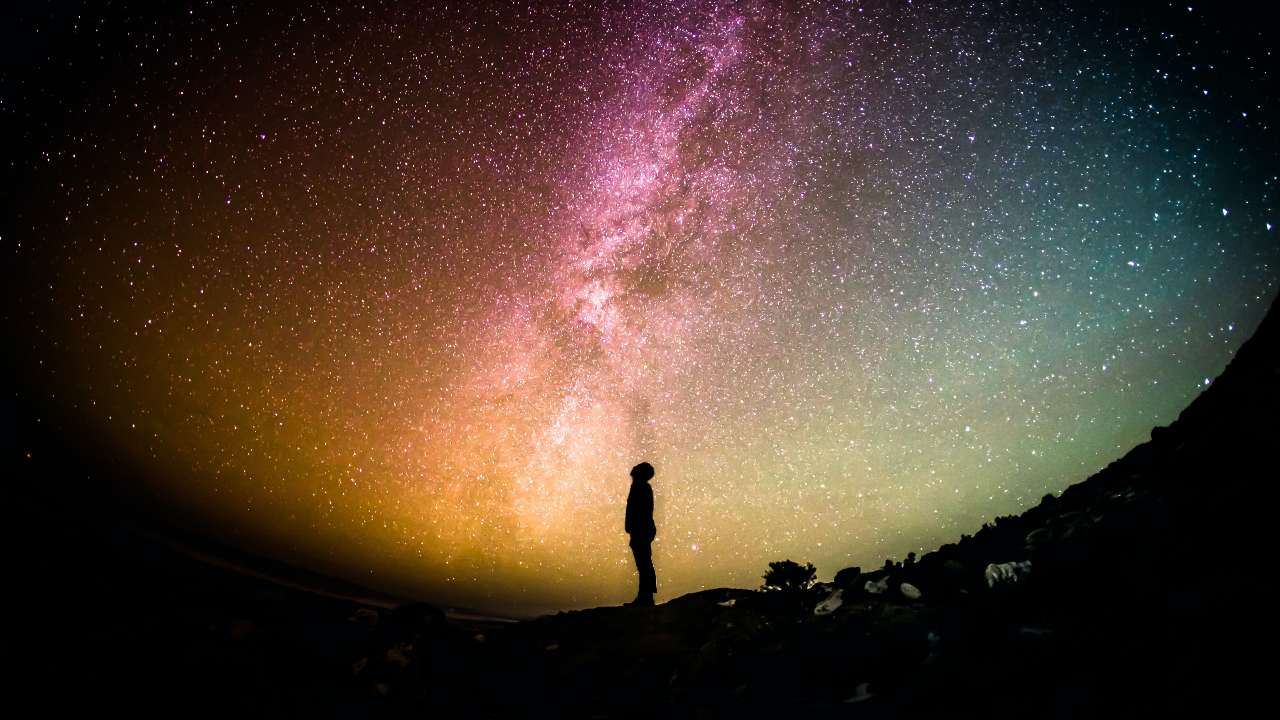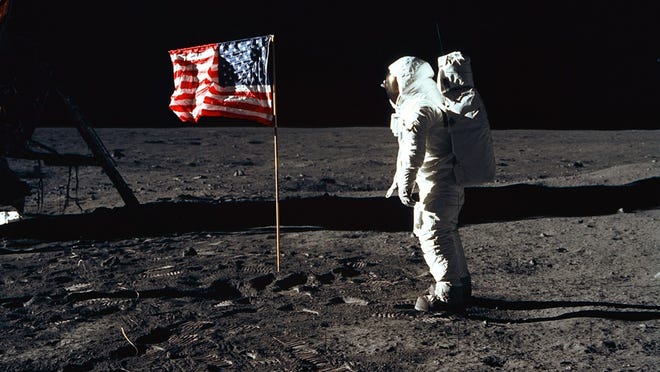
En esta ilustración, las estrellas se ven en órbita cercana alrededor del agujero negro supermasivo que acecha en el centro de la Vía Láctea, conocido como Sagitario A* (Sgr A*). Crédito: Observatorio Internacional Gemini/NOIRLab/NSF/AURA/J. da Silva/(Motor espacial), Agradecimientos: M. Zamani (NOIRLab de NSF)[2]Información precisa sobre el agujero negro supermasivo en el corazón de la Vía Láctea
Los astrónomos utilizan el Observatorio Gemini y una colaboración internacional de telescopios para arrojar luz sobre Sagitario A*
Tomada con la ayuda del telescopio Gemini North, los astrónomos han realizado las mediciones más precisas hasta el momento de los movimientos de las estrellas alrededor del supermasivo.[{” attribute=””>black hole at the center of the Milky Way. These results show that 99.9% of the mass contained at the very center of the galaxy is due to the black hole, and only 0.1% could include stars, smaller black holes, interstellar dust, and gas, or dark matter.
Los astrónomos han medido con mayor precisión la posición y la velocidad de cuatro estrellas en la vecindad de Sagitario A* (Sgr A*),[1] el agujero negro supermasivo que acecha en el centro de la Vía Láctea. Se descubrió que los movimientos de estas estrellas, llamadas S2, S29, S38 y S55, siguen caminos que muestran que la masa en el centro de la Vía Láctea se debe casi en su totalidad a Sgr A* agujero negro, dejando muy poco espacio para cualquier otra cosa.
El equipo de investigación utilizó una variedad de instalaciones astronómicas de última generación en esta investigación. Para medir las velocidades de las estrellas, utilizaron la espectroscopía Gemini Near Infrared Spectrograph (GNIRS) en Gemini North, cerca de la cima de Maunakea en Hawái, parte del Observatorio Internacional Gemini, un programa de NOIRLab de NSF, y el instrumento SINFONI. sobre el Observatorio Europeo Austral[{” attribute=””>Telescópio muito grande. O instrumento GRAVITY do VLTI foi usado para medir as posições das estrelas.
“Somos muito gratos ao Observatório Gemini, cujo instrumento GNIRS nos deu as informações críticas de que precisávamos”, disse Reinhard Genzel, diretor do Instituto Max Planck de Física Extraterrestre e co-recipiente do Prêmio Nobel de Física de 2020. “Esta pesquisa mostra o melhor da colaboração mundial.”
O Centro Galáctico da Via Láctea, localizado a cerca de 27.000 anos-luz do Sol, contém a fonte de rádio compacta Sgr A* que os astrônomos identificaram como um buraco negro supermassivo com 4,3 milhões de vezes a massa do Sol. Apesar de décadas de observações meticulosas – e o Prêmio Nobel concedido por descobrir a identidade de Sgr A*[3] — ha sido difícil demostrar de manera concluyente que la mayor parte de esta masa pertenece solo al agujero negro supermasivo y no incluye también una gran cantidad de materia, como estrellas, agujeros negrospolvo y gas interestelar, o materia oscura.

Estas imágenes anotadas, tomadas con el instrumento GRAVITY en el Interferómetro del Telescopio Muy Grande (VLTI) de ESO entre marzo y julio de 2021, muestran estrellas orbitando muy cerca de Sagitario A*, el agujero negro supermasivo en el corazón de la Vía Láctea. Se observó una de esas estrellas, llamada S29, cuando se acercaba al agujero negro a 13 mil millones de kilómetros, solo 90 veces la distancia entre el Sol y la Tierra. Otra estrella, llamada S300, fue detectada por primera vez en las nuevas observaciones del VLTI informadas por ESO.
Utilizando Gemini North en el Observatorio Internacional Gemini, un programa de NOIRLab de NSF y VLT de ESO, los astrónomos han medido con mayor precisión que nunca la posición y la velocidad de estas estrellas S29 y S55 (así como las estrellas S2 y S38) y las han encontrado. moverse de una manera que muestra que la masa en el centro de la Vía Láctea se debe casi en su totalidad al agujero negro de Sagitario A*, dejando muy poco espacio para cualquier otra cosa. Crédito: colaboración ESO/GRAVITY
“Con el Premio Nobel de Física 2020 otorgado por confirmar que Sgr A* es de hecho un agujero negro, ahora queremos ir más allá. Nos gustaría entender si hay algo más escondido en el centro de la Vía Láctea y si la relatividad general es de hecho la teoría correcta de la gravedad en este laboratorio extremo”, explicó Stefan Gillessen, uno de los astrónomos involucrados en este trabajo. “La forma más sencilla de responder a esta pregunta es seguir de cerca las órbitas de las estrellas que pasan cerca de Sgr A*”.
La teoría general de la relatividad de Einstein predice que las órbitas de las estrellas alrededor de un objeto compacto supermasivo son sutilmente diferentes de las predichas por la física newtoniana clásica. En particular, la relatividad general predice que las órbitas de las estrellas trazarán una elegante forma de roseta, un efecto conocido como Precesión de Schwarzschild. Para ver realmente las estrellas trazando esta roseta, el equipo rastreó la posición y la velocidad de cuatro estrellas en las cercanías de Sgr A*, denominadas S2, S29, S38 y S55. Las observaciones del equipo sobre el grado de precesión de estas estrellas les permitieron inferir la distribución de masa dentro de Sgr A*. Descubrieron que cualquier masa extendida dentro de la órbita de la estrella S2 contribuye como máximo con el equivalente al 0,1% de la masa del agujero negro supermasivo.
secuencia animada de[{” attribute=””>ESO’s Very Large Telescope Interferometer (VLTI) images of stars around the Milky Way’s central black hole. This animation shows the orbits of the stars S29 and S55 as they move close to Sagittarius A* (center), the supermassive black hole at the heart of the Milky Way. As we follow the stars along in their orbits, we see real images of the region obtained with the GRAVITY instrument on the VLTI in March, May, June and July 2021. In addition to S29 and S55, the images also show two fainter stars, S62 and S300. S300 was detected for the first time in new VLTI observations reported by ESO.
Measuring the minute variations in the orbits of distant stars around our galaxy’s supermassive black hole is incredibly challenging. To make further discoveries, astronomers will have to push the boundaries not only of science but also of engineering. Upcoming extremely large telescopes (ELTs) such as the Giant Magellan Telescope and the Thirty Meter Telescope (both part of the US-ELT Program) will allow astronomers to measure even fainter stars with even greater precision.
“We will improve our sensitivity even further in future, allowing us to track even fainter objects,” concluded Gillessen. “We hope to detect more than we see now, giving us a unique and unambiguous way to measure the rotation of the black hole.”
Acérquese al corazón de la Vía Láctea para ver las estrellas observadas por el Very Large Telescope del Observatorio Europeo Austral (la última observación es de 2019). El acercamiento revela estrellas aún más cercanas al agujero negro, observadas con el instrumento GRAVITY en la interferometría del Very Large Telescope de ESO a mediados de 2021.
“Los observatorios Gemini continúan brindando nueva información sobre la naturaleza de nuestra galaxia y el enorme agujero negro en su centro”, dijo Martin Still, Oficial del Programa Gemini en la Fundación Nacional de Ciencias. “Más desarrollos de instrumentos durante la próxima década destinados a un uso generalizado mantendrán el liderazgo de NOIRLab en la caracterización del Universo que nos rodea”.
Para obtener más información sobre esta investigación, consulte Mira las estrellas corriendo alrededor del agujero negro supermasivo de la Vía Láctea.
Los grados
- Se habla de Sagitario A* como “Estrella de Sagitario A”.
- El VLT de ESO está compuesto por cuatro telescopios individuales de 8,2 metros que pueden combinar luz a través de una red de espejos y túneles subterráneos mediante una técnica conocida como interferometría, para formar el VLTI. GRAVITY utiliza esta técnica para medir la posición de los objetos en el cielo nocturno con alta[{” attribute=””>accuracy — equivalent to picking out a quarter-dollar coin on the surface of the Moon.
- The 2020 Nobel Prize in Physics was awarded in part to Reinhard Genzel and Andrea Ghez “for the discovery of a supermassive compact object at the center of our galaxy.”
This research is presented in the paper “The mass distribution in the Galactic Centre from interferometric astrometry of multiple stellar orbits” which is published in Astronomy & Astrophysics. A companion paper “Deep Images of the Galactic Center with GRAVITY” has also been published in Astronomy & Astrophysics.
References:
“Mass distribution in the Galactic Center based on interferometric astrometry of multiple stellar orbits” by GRAVITY Collaboration: R. Abuter, N. Aimar, A. Amorim, J. Ball, M. Bauböck, J. P. Berger, H. Bonnet, G. Bourdarot, W. Brandner, V. Cardoso, Y. Clénet, Y. Dallilar, R. Davies, P. T. de Zeeuw, J. Dexter, A. Drescher, F. Eisenhauer, N. M. Förster Schreiber, A. Foschi, P. Garcia, F. Gao, E. Gendron, R. Genzel, S. Gillessen, M. Habibi, X. Haubois, G. Heißel,??, T. Henning, S. Hippler, M. Horrobin, L. Jochum, L. Jocou, A. Kaufer, P. Kervella, S. Lacour, V. Lapeyrère, J.-B. Le Bouquin, P. Léna, D. Lutz, T. Ott, T. Paumard, K. Perraut, G. Perrin, O. Pfuhl, S. Rabien, J. Shangguan, T. Shimizu, S. Scheithauer, J. Stadler, A.W. Stephens, O. Straub, C. Straubmeier, E. Sturm, L. J. Tacconi, K. R. W. Tristram, F. Vincent, S. von Fellenberg, F. Widmann, E. Wieprecht, E. Wiezorrek, J. Woillez, S. Yazici and A. Young, 19 January 2022, Astronomy & Astrophysics.
DOI: 10.1051/0004-6361/202142465
“Deep images of the Galactic center with GRAVITY” by GRAVITY Collaboration: R. Abuter, N. Aimar, A. Amorim, P. Arras, M. Bauböck, J. P. Berger, H. Bonnet, W. Brandner, G. Bourdarot, V. Cardoso, Y. Clénet, R. Davies, P. T. de Zeeuw, J. Dexter, Y. Dallilar, A. Drescher, F. Eisenhauer, T. Enßlin, N. M. Förster Schreiber, P. Garcia, F. Gao, E. Gendron, R. Genzel, S. Gillessen, M. Habibi, X. Haubois, G. Heißel, T. Henning, S. Hippler, M. Horrobin, A. Jiménez-Rosales, L. Jochum, L. Jocou, A. Kaufer, P. Kervella, S. Lacour, V. Lapeyrère, J.-B. Le Bouquin, P. Léna, D. Lutz, F. Mang, M. Nowak, T. Ott, T. Paumard, K. Perraut, G. Perrin, O. Pfuhl, S. Rabien, J. Shangguan, T. Shimizu, S. Scheithauer, J. Stadler, O. Straub, C. Straubmeier, E. Sturm, L. J. Tacconi, K. R. W. Tristram, F. Vincent, S. von Fellenberg, I. Waisberg, F. Widmann, E. Wieprecht, E. Wiezorrek, J. Woillez, S. Yazici, A. Young and G. Zins, 19 January 2022, Astronomy & Astrophysics.
DOI: 10.1051/0004-6361/202142459
More information
The team behind this result is composed of The GRAVITY Collaboration, R. Abuter (European Southern Observatory), A. Amorim (Universidade de Lisboa and CENTRA – Centro de Astrofísica e Gravitação), M. Bauböck (Max Planck Institute for Extraterrestrial Physics and University of Illinois), J. P. Berger (University Grenoble Alpes and European Southern Observatory), H. Bonnet (European Southern Observatory), G. Bourdarot (University Grenoble Alpes and Max Planck Institute for Extraterrestrial Physics), V. Cardoso (CENTRA – Centro de Astrofísica e Gravitação and CERN), Y. Clénet (LESIA, Observatoire de Paris), Y. Dallilar (Max Planck Institute for Extraterrestrial Physics), R. Davies (Max Planck Institute for Extraterrestrial Physics), P. T. de Zeeuw (Leiden University and Max Planck Institute for Extraterrestrial Physics), J. Dexter (University of Colorado, Boulder), A. Drescher (Max Planck Institute for Extraterrestrial Physics), A. Eckart (University of Cologne and Max Planck Institute for Radio Astronomy), F. Eisenhauer (Max Planck Institute for Extraterrestrial Physics), N. M. Förster Schreiber (Max Planck Institute for Extraterrestrial Physics), P. Garcia (Universidade do Porto and CENTRA – Centro de Astrofísica e Gravitação), F. Gao (Universität Hamburg and Max Planck Institute for Extraterrestrial Physics), E. Gendron (LESIA, Observatoire de Paris), R. Genzel (Max Planck Institute for Extraterrestrial Physics and University of California, Berkeley), S. Gillessen (Max Planck Institute for Extraterrestrial Physics), M. Habibi (Max Planck Institute for Extraterrestrial Physics), X. Haubois (European Southern Observatory), G. Heißel (LESIA, Observatoire de Paris), T. Henning (Max Planck Institute for Astronomy), S. Hippler (Max Planck Institute for Astronomy), M. Horrobin (University of Cologne), L. Jochum (European Southern Observatory), L. Jocou (University Grenoble Alpes), A. Kaufer (European Southern Observatory), P. Kervella (LESIA, Observatoire de Paris), S. Lacour (LESIA, Observatoire de Paris), V. Lapeyrère (LESIA, Observatoire de Paris), J.-B. Le Bouquin (University Grenoble Alpes), P. Léna (LESIA, Observatoire de Paris), D. Lutz (Max Planck Institute for Extraterrestrial Physics), T. Ott (Max Planck Institute for Extraterrestrial Physics), T. Paumard (LESIA, Observatoire de Paris), K. Perraut (University Grenoble Alpes), G. Perrin (LESIA, Observatoire de Paris), O. Pfuhl (European Southern Observatory and Max Planck Institute for Extraterrestrial Physics), S. Rabien (Max Planck Institute for Extraterrestrial Physics), G. Rodríguez-Coira (LESIA, Observatoire de Paris), J. Shangguan (Max Planck Institute for Extraterrestrial Physics), T. Shimizu (Max Planck Institute for Extraterrestrial Physics), S. Scheithauer (Max Planck Institute for Astronomy), J. Stadler (Max Planck Institute for Extraterrestrial Physics), O. Straub (Max Planck Institute for Extraterrestrial Physics), C. Straubmeier (University of Cologne), E. Sturm (Max Planck Institute for Extraterrestrial Physics), L. J. Tacconi (Max Planck Institute for Extraterrestrial Physics), K. R. W. Tristram (European Southern Observatory), F. Vincent (LESIA, Observatoire de Paris), S. von Fellenberg (Max Planck Institute for Extraterrestrial Physics), F. Widmann (Max Planck Institute for Extraterrestrial Physics), E. Wieprecht (Max Planck Institute for Extraterrestrial Physics), E. Wiezorrek (Max Planck Institute for Extraterrestrial Physics), J. Woillez (European Southern Observatory), S. Yazici (Max Planck Institute for Extraterrestrial Physics and the University of Cologne), and A. Young (Max Planck Institute for Extraterrestrial Physics).

“Creador malvado. Estudiante. Jugador apasionado. Nerd incondicional de las redes sociales. Adicto a la música”.






